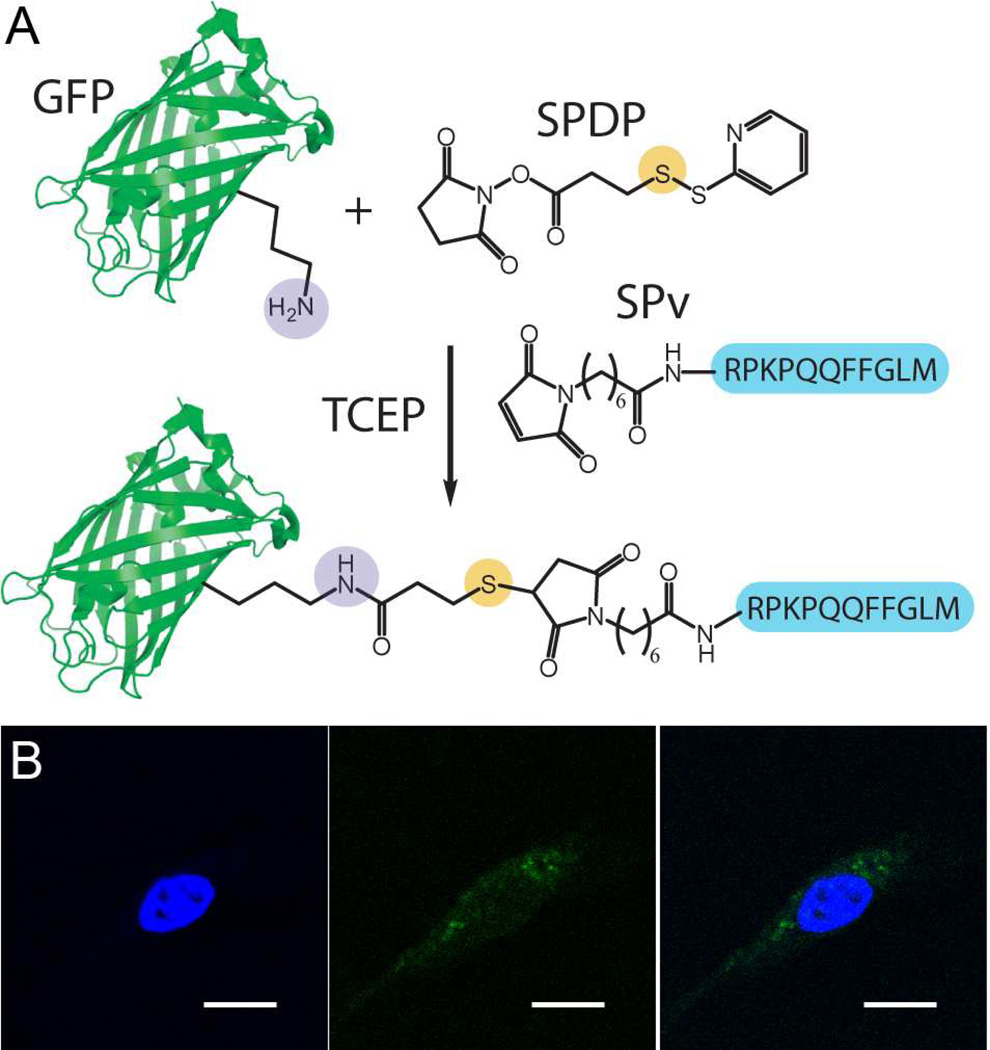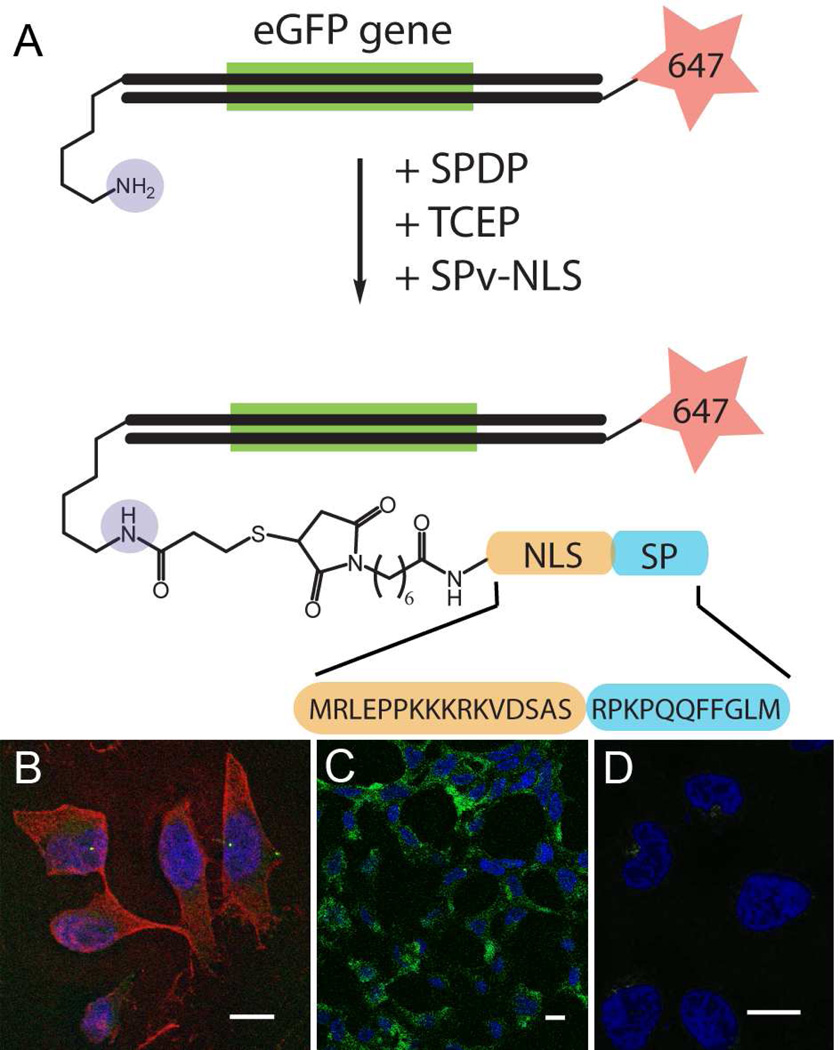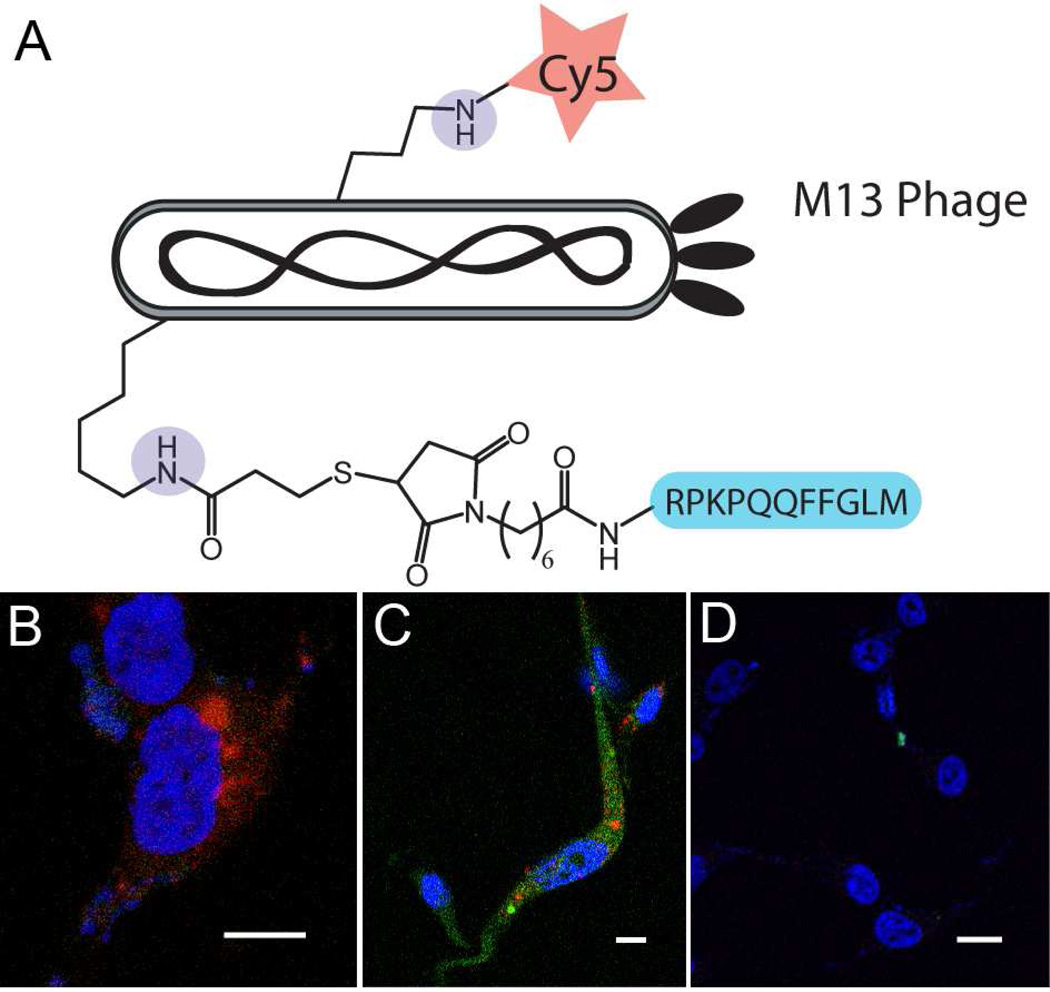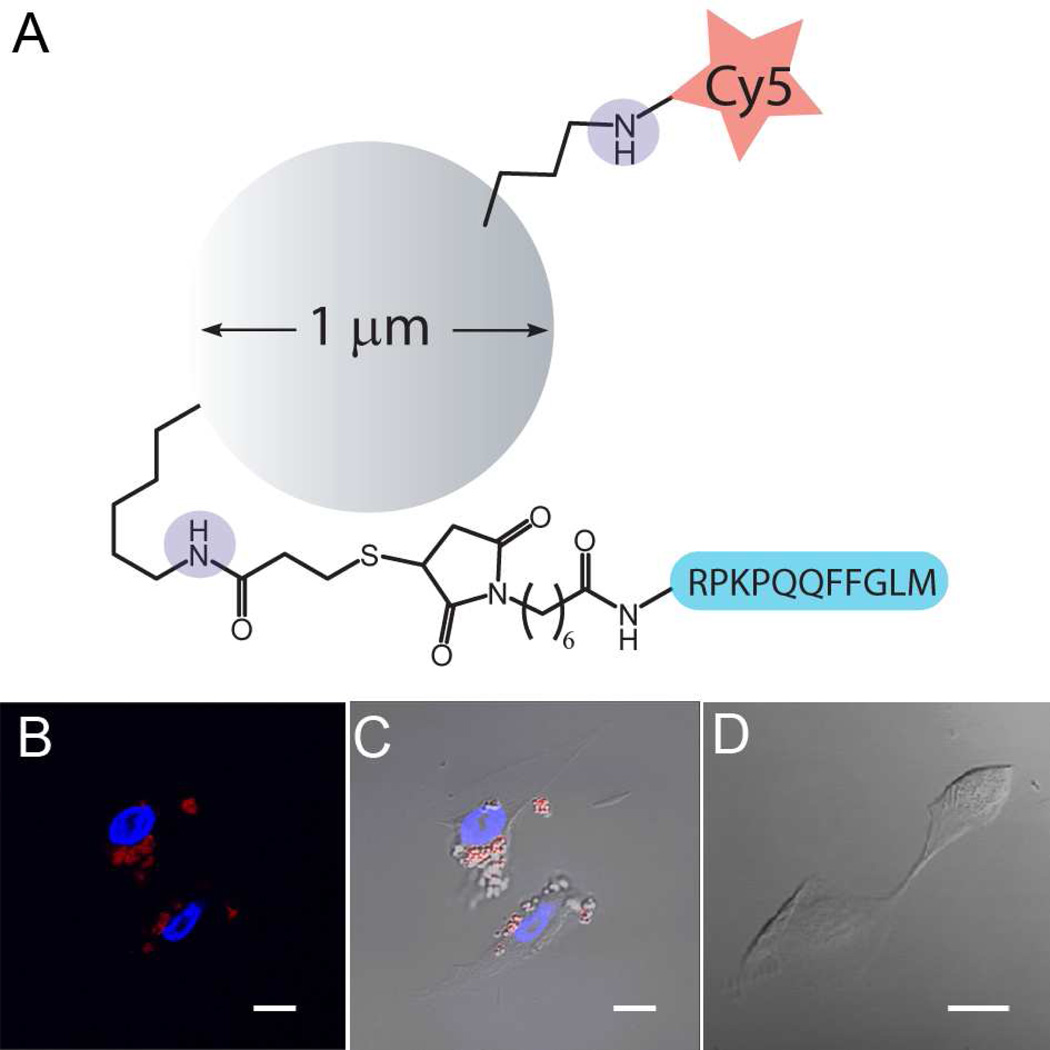Abstract
The use of proteins or nucleic acids as therapeutic agents has been severely hampered by their intrinsic inability to cross the cell membrane. Moreover, common techniques for driving the delivery of macromolecules lack the ability to distinguish between healthy and diseased tissue, precluding their clinical use. Recently, receptor-mediated delivery (RMD) has emerged as a technology with the potential to circumvent the obstacles associated with the delivery of drug targets by utilizing the natural endocytosis of a ligand upon binding to its hormone. Here, we describe the synthesis of variants of substance P (SP), an eleven amino acid neuropeptide ligand of the neurokinin type 1 receptor (NK1R), for the delivery of various types of cargo. The variants of SP were synthesized with an N-terminal maleimide moiety that allows conjugation to surface thiols, resulting in a non-reducible thioether. Cargos lacking an available thiol are conjugated to SP using commercially available cross-linkers. In addition to the delivery of proteins, we expand the use of SP to include nuclear delivery of DNA fragments that are actively expressed in the target cells. We also show that SP can be used to deliver whole bacteriophage particles as well as polystyrene beads up to 1 µm in diameter. The results show the ability of SP to deliver cargo of various sizes and chemical properties that retain their function within the cell. Furthermore, the over-expression of the NK1R in many tumors provides the potential for developing targeted delivery reagents that are specific towards diseased tissue.
Targeted delivery of drug molecules to diseased cells without affecting healthy tissue is of great importance for therapeutic applications. While transfection reagents are commonly used to transport nucleic acids across the cell membranes of eukaryotic cells, such reagents can be associated with a great deal of toxicity and lack cell type specificity, precluding their use for in vivo applications1–3. Recently, receptor-mediated delivery (RMD) strategies have been developed to overcome the hurdles associated with targeted drug delivery4–9. RMD takes advantage of the over-expression of a receptor on the surface of diseased tissue in comparison to the surrounding healthy cells. By conjugating a drug to the ligand of the over-expressed receptor, the drug is internalized along with the ligand as part of the natural endocytic pathway associated the ligand-receptor interaction. Several examples of RMD have been reported with varying degrees of success, and some have been employed for in vivo delivery10, 11.
Previously, we and others developed substance P (SP), an eleven-amino acid neuropeptide (Sequence: RPKPQQFFGLM-NH2), into a robust vehicle for the delivery of synthetic antibodies (sABs)8 and toxins12. SP is internalized through a high-affinity interaction with the neurokinin 1 receptor (NK1R)13, 14, a tachykinin receptor that is highly over-expressed in many tumors15, 16, particularly in brain cancers17, 18 compared to normal human astrocytes, where its expression is undetectable8. SP-conjugated proteins were shown to specifically target glioblastoma cells. Importantly, we demonstrated a sufficient fraction of the introduced cargos escape the endosome to elicit and phenotype that resembles their function in vitro8.
Here, we utilize two synthetic variants of SP (SPv and SPv-NLS) for the conjugation and delivery of molecular cargo that vary in size and chemical properties. Both SPv and SPv-NLS were synthesized to contain an N-terminal maleimide moiety followed by a 6-carbon linker. SPv-NLS contains an additional nuclear localization sequence between the N-terminal melimide and the SP sequence. The maleimide of SPv and SPv-NLS can be conjugated to cysteine residues on a protein surface or a thiol-containing crosslinkers. Additionally, the nuclear localization sequence of SPv-NLS mediated the delivery of cargo to the nucleus. We present a general method for the conjugation of SP variants to highly diverse types of molecular cargo and demonstrate that conjugation to SP can be used to deliver proteins, double stranded DNA fragments, phage particles and polystyrene beads up to 1 µm in diameter to cells expressing the NK1R. The high affinity of the interaction between SP and the NK1R, combined with the over-expression of the receptor in many cancers makes SP-mediated delivery a potential tool for the development of highly specific therapeutic agents.
The maleimide moiety of SPv is designed to directly react with a cysteine residue on a cargo protein to form a stable thioether. However, for many proteins, a surface cysteine residue may not always be available for conjugation. To establish a general method for attachment of SPv to proteins that have no modifiable surface cysteines, we used GFP (green fluorescent protein) as a cargo. Additionally, the fluorescence of GFP serves to directly detect uptake by mammalian cells expressing the NK1R. First, GFP was reacted with the heterobifunctional crosslinker SPDP (N -Succinimidyl 3-(2-pyridyldithio)-propionate), which modifies surface lysine residues to produce a pyridyldithiol functional group (Fig. 1A). Second, the isolated SPDP-GFP conjugate was reacted with a 50-fold excess of SPv in the presence of 1 mM TCEP (tris(2-carboxyethyl) phosphine). Upon reduction of the pyridyldithio-group by TCEP, the exposed thiol reacts with the maleimide of SPv to produce a stable thioether linkage between the peptide and the protein. Finally, the SPv-GFP conjugate was isolated by size-exclusion chromatography.
Figure 1.
Delivery of GFP. A. The cross linker SPDP is used to modify the amine group of a lysine residue (blue) to pyridyl-dithiol. Reduction using TCEP exposes a free thiol (yellow), which reacts with the N-terminal maleimide moiety of SPv to form a thioether. B. U87 cell treated with 20 nM GFP-SPv conjugate; nuclear stain (left), GFP fluorescence (center), merged channels (right). (Scale bar = 10 µm).
To examine the ability of SPv to mediate the delivery of GFP, we utilized U87 glioblastoma cells, which highly express the NK1R17. The cells were seeded on cover slips in a 24-well plate and treated with 100 nM of the SPv-GFP conjugate for 2 hours. The cells were then washed 3 times with phosphate buffered saline (PBS) to remove un-internalized conjugate and fixed with 4% p-formaldehyde. DAPI was used for nuclear staining followed by mounting of the cover slips on glass slides and visualization under confocal microscopy. The images show that GFP is readily internalized by U87 cells demonstrating that SPv conjugation results in uptake of the protein cargo by cells containing the NK1R (Fig. 1B).
The specific delivery of genetic material to a diseased cell is a great challenge in gene therapy. To examine the ability of SP variants to deliver a gene that can be functionally expressed in mammalian cells, we designed a linear DNA fragment that includes the CMV promoter followed by the enhanced green fluorescent protein (eGFP) gene. The fragment was designed to utilize GFP expression as an indication of functional expression of the DNA molecule. The fragment was generated by PCR using oligonucleotides with incorporated modifications at the 5’ ends. The sense primer was designed with a 5’ Alexa 647 fluorescent group and the anti-sense primer included a 5’ amine modification. We conjugated the PCR fragment to SPv-NLS using SPDP in a two-step reaction (Fig. 2A). First, the amine-reactive NHS-ester of SPDP was reacted with the amine modification of the PCR fragment, followed by size exclusion chromatography to isolate the SP-DNA conjugate. Second, the conjugate was mixed with a 50-fold molar excess of SPv-NLS in the presence of TCEP to allow the maleimide of SPv-NLS to react with the pyridylodithio-group of SPDP to form a thioether linkage (Fig. 2A). The final product was purified by size exclusion chromatography, and the 5’ Alexa 647 group was used to estimate the concentration of the conjugate.
Fig. 2.
Delivery of functionally-expressed DNA fragment. A. A DNA fragment coding for GFP was generated by PCR with the introduction of Alexa-647 fluorophore (red) and a free amine (blue). SPDP was used to conjugate the DNA fragment to SPv-NLS, which contains an N-terminal maleimde, followed by a nuclear localization sequence (orange) and the SP sequence. B. Hela cells transfected with the NK1R show internalization of the DNA conjugate (red) with both cytoplasmic and nuclear localization after 2 hrs of treatment with 200 pM DNA-SPv-NLS conjugate, and C. GFP expression (green) after 48 hrs of treatment. D. Hela cells treated with DNA fragment not conjugated to SP. (Scale bar = 10 µm).
To demonstrate SP-mediated delivery of an expressible gene, we utilized HeLa cells transfected with a plasmid that codes for the NK1R. The cells were treated with 200 pM of the SP-linear DNA conjugate 48 hrs after transfection, where expression of the NK1R was confirmed by western blot (supporting figure). After 2, 24 and 48 hrs incubation with the conjugate, cells were fixed and stained with DAPI and examined using confocal microscopy. The results show that cells expressing the NK1R readily internalize the linear DNA conjugate within 2 hrs of treatment (Fig. 2B). Further, the conjugate appears to localize throughout the cytoplasm and the nucleus. GFP expression was observed after 48 hrs of incubation with the conjugate (Fig. 2C) compared to cells treated with the PCR fragment alone (Fig. 2D), indicating the ability of the conjugate to retain its activity following internalization through the SP-NK1R interaction. The results also show that a subnanomolar concentration of the SP-gene conjugate can effectively result in functional expression in the target cells.
For the potential therapeutic utilization of the delivery of genetic material, protection of the DNA molecule can serve to elongate the life of the cargo within circulation by avoiding degradation. We sought to deliver DNA molecules packaged within bacteriophage particles, a strategy that provides several advantages. First, the simple architecture of the phage coat proteins is highly stable providing protection of the encapsulated DNA molecule. Second, the self-assembly of the phage components can be used to easily package any plasmid that contains an F1 origin of replication. Third, the N-termini of the thousands of copies of the major coat protein pVIII are solvent exposed and can be used for attachment of SP variants without interfering with the DNA molecule itself. While receptor mediated delivery of phage particles has previously been reported, the efficiency of delivery and functional expression of the encoded gene has been poor19, 20. This is because the packaged DNA is single stranded, and therefore, successful delivery of useful genetic material using phage particles requires disassembly of the phage coat upon internalization, release of the DNA cargo and conversion of the ssDNA into dsDNA. Each of these steps can potentially form an obstacle for the delivery of transcriptionally competent DNA.
To generate phage particles packaged with peGFP-F ssDNA (Fig. 3A), mid-log phase XL-1 blue cells carrying the peGFP-F plasmid were infected with KO7 helper phage and incubated overnight at 37°C, followed by polyethylene glycol/NaCl precipitation of the phage particles. We modified the surface amines of the phage particles using a 20-fold excess of SPDP, followed by 3 phage precipitation/re-suspension steps to remove excess crosslinker, and addition of 100-fold excess of SPv. The surface amines were also used to attach NHS-cy5 for visualization of the internalized phage particles. Incubation of U87 glioblastoma cells with the SP-phage conjugate results in internalization of the phage particles as indicated by confocal microscopy (Fig. 3B). After 72 hrs of incubation, GFP expression was observed only in cells treated with the conjugate (Fig. 3C, D), indicating selective targeting of the conjugate by SP to U87 cells. While the efficiency of delivery of the phage particles is high, the efficiency of GFP expression is low. FACS analysis indicates that ~1 in 500 cells that internalize the conjugate are able to express GFP. While this is significantly above background green fluorescence (1 in 10,000 cells), this percentage remains low, and correlates with previously published studies where genetically modified phage particles displaying a protein ligand are used for gene delivery19, 20.
Figure 3.
Delivery of bacteriophage. A. M13 KO7 phage particles carrying ssDNA coding for GFP were conjugated to SPv via SPDP and labeled with cy5. B. U87 cells treated with phage-SPv conjugates showing internalization of the phage particles (red) after 2 hrs. C. GFP expression (green) in U87 cells, 72 hrs after treatment with the phage-SPv particles. D. U87 cells treated with cy5 labeled phage not conjugated to SPv, 72 hrs following treatment. (Scale bar = 10 µm).
We establish here that SP can deliver molecules of size and volume several times greater than the previously reported cargos8, 12. To determine the size limit of the cargo that can be delivered using SP, we investigated the ability of the engineered SP variants to deliver polystyrene bead that are 1 or 6 µm in diameter. The beads, which contain an amine-derivatized surface, were conjugated to SPv using SPDP. Additionally, NHS-cy5 was added to the reaction to fluorescently label the surface of the beads, which were then isolated from excess crosslinker, SPv and fluorophore by centrifugation (Fig. 4A). Confocal imaging of U87 cells treated with SPv conjugated to 1 µm beads shows that the beads were internalized (Fig. 4B). A z-stack series of the cells shows that the beads lie within the cytoplasm surrounding the nucleus (supporting video). The cells failed to internalize larger-sized beads conjugated to SP, providing an estimate of 1 µm for the upper limit for the size of cargo that can be delivered using SP. However, the large size of the beads produced protrusions of the cell membrane surrounding the internalized beads (Fig, 4C), distorting their shape compared to untreated cells (Fig. 4D). Delivery of beads, to our knowledge, has not previously been reported. This capability of SP variants can potentially be utilized to carryout optical trapping experiments to measure the forces exerted on a modified bead within live cells, provided that the beads do not interfere with the viability of the cells.
Figure 4.
Delivery of polystyrene beads. A. Amine-modified 1 µm polystyrene beads were conjugated to SPv using SPDP, and labeled with cy5. B. U87 cells treated with SPv-conjugated beads readily uptake the beads (red) 2 hrs following treatment. C. Merged channels in B with DIC showing distortion of cell membrane upon internalization of beads. D. Untreated cells. (Scale bar = 10 µm).
In this work, we describe the synthesis of two variants of the neuropeptide Substance P and their utilization as tools for the conjugation and receptor mediated delivery of a wide variety of molecular cargos to mammalian cells. Both variants (SPv and SPv-NLS) contain a maleimide moiety at the N-terminus allowing conjugation to myriad molecular cargo types. Using thiol- and amine-reactive groups, all the conjugation reactions described here can be carried out efficiently under mild conditions that preserve the activity of the cargo.
Utilizing SP as a vehicle for the delivery of molecular cargo offers notable advantages over many other ligands. Unlike large proteins, the 11-amino acid sequence of SP can be easily synthesized allowing the incorporation of a variety of chemical groups for conjugation to the cargo. Additionally, SP binds to the NK1R with high affinity (~100 pM)21, requiring a small dose of the SP-cargo conjugate for successful delivery. Importantly, the NK1R is highly over-expressed in many tumors compared to the surrounding tissue15–18, 22, providing a tool for specific targeting of the tumor tissue without affecting healthy cells. Further, the incorporated cargos adequately escape the endosome in most cases.
Our results demonstrate the versatility of the engineered SP variants for the delivery of various types of molecules. Cargos as large as a 1 µm bead can be readily internalized upon conjugation to SPv. In addition, we demonstrate that SP variants can transport genetic material across the cell membrane in two forms; dsDNA fragment and phage-packaged ssDNA. In both cases, the DNA was functionally expressed as indicated by green fluorescence. However, the mechanism by which the cargo is released from the endosome is still not clear and may be cargo-dependent. Even with efficient internalization, a low level of endosomal escape can contribute to the low efficiency of the function of the delivered cargo. For the case of delivering protein cargos via SP conjugation, endosomal escape appears to be relatively efficient, although it is difficult to quantify. In the cases of gene delivery described here, a small number of DNA molecules that escape the endosome can translate into a significant amount of gene expression. This may be different for the delivery of other types of cargo that require larger doses for intracellular activity. Clearly, more work must to be done to increase the efficiency of the function of the delivered cargo. Nonetheless, the utilization of SP variants for delivery of DNA can lead to the development of novel approached to gene-based therapies.
Supplementary Material
Acknowledgements
The authors thank Dr. Labno and Dr. Bindokas at the University of Chicago Microscopy core facility. This work was funded by U54GM087519. SSR was funded by NIH F32DK080619.
Footnotes
Supporting information:
Detailed materials and methods, as well as one supporting figure and one supporting video are included. This information is available free of charge via the Internet at http://pubs.acs.org/.
References
- 1.Dalby B, Cates S, Harris A, Ohki EC, Tilkins ML, Price PJ, Ciccarone VC. Advanced transfection with Lipofectamine 2000 reagent: primary neurons, siRNA, and high-throughput applications. Methods. 2004;33:95–103. doi: 10.1016/j.ymeth.2003.11.023. [DOI] [PubMed] [Google Scholar]
- 2.Felgner PL, Gadek TR, Holm M, Roman R, Chan HW, Wenz M, Northrop JP, Ringold GM, Danielsen M. Lipofection: a highly efficient, lipid-mediated DNA-transfection procedure. Proc Natl Acad Sci U S A. 1987;84:7413–7417. doi: 10.1073/pnas.84.21.7413. [DOI] [PMC free article] [PubMed] [Google Scholar]
- 3.Jacobsen LB, Calvin SA, Colvin KE, Wright M. FuGENE 6 Transfection Reagent: the gentle power. Methods. 2004;33:104–112. doi: 10.1016/j.ymeth.2003.11.002. [DOI] [PubMed] [Google Scholar]
- 4.Atkinson TJ. Cystic fibrosis, vector-mediated gene therapy, and relevance of toll-like receptors: a review of problems, progress, and possibilities. Curr Gene Ther. 2008;8:201–207. doi: 10.2174/156652308784746468. [DOI] [PubMed] [Google Scholar]
- 5.Gust TC, Zenke M. Receptor-mediated gene delivery. Scientific World Journal. 2002;2:224–229. doi: 10.1100/tsw.2002.95. [DOI] [PMC free article] [PubMed] [Google Scholar]
- 6.Maruyama K, Iwasaki F, Takizawa T, Yanagie H, Niidome T, Yamada E, Ito T, Koyama Y. Novel receptor-mediated gene delivery system comprising plasmid/protamine/sugar-containing polyanion ternary complex. Biomaterials. 2004;25:3267–3273. doi: 10.1016/j.biomaterials.2003.10.004. [DOI] [PubMed] [Google Scholar]
- 7.Pardridge WM. shRNA and siRNA delivery to the brain. Adv Drug Deliv Rev. 2007;59:141–152. doi: 10.1016/j.addr.2007.03.008. [DOI] [PMC free article] [PubMed] [Google Scholar]
- 8.Rizk SS, Luchniak A, Uysal S, Brawley CM, Rock RS, Kossiakoff AA. An engineered substance P variant for receptor-mediated delivery of synthetic antibodies into tumor cells. Proc Natl Acad Sci U S A. 2009;106:11011–11015. doi: 10.1073/pnas.0904907106. [DOI] [PMC free article] [PubMed] [Google Scholar]
- 9.Tian P, Ren S, Ren C, Teng Q, Qu S, Yao M, Gu J. A novel receptor-targeted gene delivery system for cancer gene therapy. Sci China C Life Sci. 1999;42:216–224. doi: 10.1007/BF02880059. [DOI] [PubMed] [Google Scholar]
- 10.Wiley RG, Lappi DA. Targeted toxins in pain. Adv Drug Deliv Rev. 2003;55:1043–1054. doi: 10.1016/s0169-409x(03)00102-9. [DOI] [PubMed] [Google Scholar]
- 11.Katsogiannou M, Peng L, Catapano CV, Rocchi P. Active-Targeted Nanotherapy Strategies for Prostate Cancer. Curr Cancer Drug Targets. 2011;11:954–965. doi: 10.2174/156800911797264770. [DOI] [PubMed] [Google Scholar]
- 12.Mantyh PW, Rogers SD, Honore P, Allen BJ, Ghilardi JR, Li J, Daughters RS, Lappi DA, Wiley RG, Simone DA. Inhibition of hyperalgesia by ablation of lamina I spinal neurons expressing the substance P receptor. Science. 1997;278:275–279. doi: 10.1126/science.278.5336.275. [DOI] [PubMed] [Google Scholar]
- 13.Garland AM, Grady EF, Payan DG, Vigna SR, Bunnett NW. Agonist-induced internalization of the substance P (NK1) receptor expressed in epithelial cells. Biochem J. 1994;303(Pt 1):177–186. doi: 10.1042/bj3030177. [DOI] [PMC free article] [PubMed] [Google Scholar]
- 14.Wang X, Marvizon JC. Time-course of the internalization and recycling of neurokinin 1 receptors in rat dorsal horn neurons. Brain Res. 2002;944:239–247. doi: 10.1016/s0006-8993(02)02918-9. [DOI] [PubMed] [Google Scholar]
- 15.Hennig IM, Laissue JA, Horisberger U, Reubi JC. Substance-P receptors in human primary neoplasms: tumoral and vascular localization. Int J Cancer. 1995;61:786–792. doi: 10.1002/ijc.2910610608. [DOI] [PubMed] [Google Scholar]
- 16.Singh D, Joshi DD, Hameed M, Qian J, Gascon P, Maloof PB, Mosenthal A, Rameshwar P. Increased expression of preprotachykinin-I and neurokinin receptors in human breast cancer cells: implications for bone marrow metastasis. Proc Natl Acad Sci U S A. 2000;97:388–393. doi: 10.1073/pnas.97.1.388. [DOI] [PMC free article] [PubMed] [Google Scholar]
- 17.Palma C, Maggi CA. The role of tachykinins via NK1 receptors in progression of human gliomas. Life Sci. 2000;67:985–1001. doi: 10.1016/s0024-3205(00)00692-5. [DOI] [PubMed] [Google Scholar]
- 18.Lai JP, Douglas SD, Wang YJ, Ho WZ. Real-time reverse transcription-PCR quantitation of substance P receptor (NK-1R) mRNA. Clin Diagn Lab Immunol. 2005;12:537–541. doi: 10.1128/CDLI.12.4.537-541.2005. [DOI] [PMC free article] [PubMed] [Google Scholar]
- 19.Kassner PD, Burg MA, Baird A, Larocca D. Genetic selection of phage engineered for receptor-mediated gene transfer to mammalian cells. Biochem Biophys Res Commun. 1999;264:921–928. doi: 10.1006/bbrc.1999.1603. [DOI] [PubMed] [Google Scholar]
- 20.Chung YS, Sabel K, Kronke M, Klimka A. Gene transfer of Hodgkin cell lines via multivalent anti-CD30 scFv displaying bacteriophage. BMC Mol Biol. 2008;9:37. doi: 10.1186/1471-2199-9-37. [DOI] [PMC free article] [PubMed] [Google Scholar]
- 21.Gether U, Marray T, Schwartz TW, Johansen TE. Stable expression of high affinity NK1 (substance P) and NK2 (neurokinin A) receptors but low affinity NK3 (neurokinin B) receptors in transfected CHO cells. FEBS Lett. 1992;296:241–244. doi: 10.1016/0014-5793(92)80295-r. [DOI] [PubMed] [Google Scholar]
- 22.Yamaguchi K, Richardson MD, Bigner DD, Kwatra MM. Signal transduction through substance P receptor in human glioblastoma cells: roles for Src and PKC delta. Cancer Chemotherapy and Pharmacology. 2005;56:585–593. doi: 10.1007/s00280-005-1030-3. [DOI] [PubMed] [Google Scholar]
Associated Data
This section collects any data citations, data availability statements, or supplementary materials included in this article.






